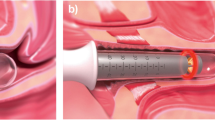Abstract
This committee opinion reviews the laser-based vaginal devices for treatment of genitourinary syndrome of menopause, vaginal laxity, and stress urinary incontinence. The United States Food and Drug Administration has issued a warning for unsubstantiated advertising and use of energy-based devices. Well-designed case–control studies are required to further investigate the potential benefits, harm, and efficacy of laser therapy in the treatment of genitourinary syndrome of menopause, vaginal laxity, and stress urinary incontinence. The therapeutic advantages of nonsurgical laser-based devices in urogynecology can only be recommended after robust clinical trials have demonstrated their long-term complication profile, safety, and efficacy.
Similar content being viewed by others
References
Salvatore S, et al. Histological study on the effects of microablative fractional CO2 laser on atrophic vaginal tissue: an ex vivo study. Menopause. 2015;22(8):845–9.
FDA. FDA warns against use of energy-based devices to perform vaginal 'rejuvenation' or vaginal cosmetic procedures: FDA Safety Communication. 2018. [2018 August 1].
Practice, C.o.G. ACOG Committee opinion no. 378: vaginal rejuvenation and cosmetic vaginal procedures. Obstet Gynecol. 2007;110(3):737.
American-College-of-Plastic-Surgeons. Nonsurgical vaginal rejuvenation. 2018. [29 October 2018]. Available from: https://www.plasticsurgery.org/cosmetic-procedures/nonsurgical-vaginal-rejuvenation.
Nappi RE, et al. Vulvar and vaginal atrophy in four European countries: evidence from the European REVIVE survey. Climecteric. 2016;19:188–97.
Portman DJ, ML G. Vulvovaginal atrophy terminology consensus conference panel. Genitourinary syndrome of menopause: new terminology for vulvovaginal atrophy from the International Society for the Study of Women's sexual health and the North American Menopause Society. Menopause. 2014;21:1063–8.
Pardo JS, Solà VD, Ricci PA. Colpoperineoplasty in women with a sensation of a wide vagina. Acta Obstet Gynecol Scand. 2006;85:1125–7.
Moore RD, Miklos JR, O C. Evaluation of sexual function outcomes in women undergoing vaginal rejuvenation/vaginoplasty procedures for symptoms of vaginal laxity/decreased vaginal sensation utilizing validated sexual function questionnaire (PISQ-12). Surg Technol Int. 2014;24:253–60.
Haylen BT, et al. An International Urogynecological Association (IUGA)/International Continence Society (ICS) joint report on the terminology for female pelvic organ prolapse (POP). Neurourol Urodyn. 2016;35(2):137–68.
Pauls RN, Fellner AN, GW D. Vaginal laxity: a poorly understood quality of life problem; a survey of physician members of the International Urogynecological Association (IUGA). Int Urogynecol J. 2012;23:1435–48.
Millheiser L, Kingsberg S, Pauls R. A cross-sectional survey to assess the prevalence and symptoms associated with laxity of the vaginal introitus [abstract 206]. In: ICS Annual Meeting. Toronto, Ontario, Canada; 2010.
Roos AM, Sultan AH, R T. Sexual problems in the gynecology clinic: are we making a mountain out of a molehill? Int Urogynecol J. 2012;23:145–52.
MacLennan AH, Taylor AW, Wilson DH. The prevalence of pelvic floor disorders and their relationship to gender, age, parity and mode of delivery. BJOG. 2000;107:1460–70.
Karcher C, N S. Vaginal rejuvenation using energy-based devices. Int J Womens Dermatol. 2016;2:85–8.
Tadir Y, et al. Light and energy based therapeutics for genitourinary syndrome of menopause: consensus and controversies. Lasers Surg Med. 2017;49:137–59.
Lang P, Karram M. Lasers for pelvic floor dysfunctions: is there evidence? Curr Opin Obstet Gynecol. 2017;29(5):354–8.
Arunkalaivanan A, Kaur H, Onuma O. Laser therapy as a treatment modality for genitourinary syndrome of menopause: a critical appraisal of evidence. Int Urogynecol J. 2017;28:681–5.
Isaza PG, Jaguszewska K, Cardona JL, Lukaszuk M. Long-term effect of thermoablative fractional CO2 laser treatment as a novel approach to urinary incontinence management in women with genitourinary syndrome of menopause. Int Urogynecol J. 2018;29(2):211–5.
Lapii GA, Yakovleva AY, Neimark AI. Structural reorganization of the vaginal mucosa in stress urinary incontinence under conditions of Er:YAG laser treatment. Bull Exp Biol Med. 2017;162(4):510–4.
Alexiades-Armenakas MR, Dover JS, Arndt KA. The spectrum of laser skin resurfacing: nonablative, fractional, and ablative laser resurfacing. J Am Acad Dermatol. 2008;58(5):719–37.
Pitsouni E, et al. Microablative fractional CO2-laser therapy and the genitourinary syndrome of menopause: an observational study. Maturitas. 2016;94:131–6.
Siliquini GP, et al. Fractional CO2 laser therapy: a new challenge for vulvovaginal atrophy in postmenopausal women. Climacteric. 2017;20(4):379–84.
Sokol ER, Karram MM. An assessment of the safety and efficacy of a fractional CO2 laser system for the treatment of vulvovaginal atrophy. Menopause. 2016;23(10):1102–7.
Sokol ER, Karram MM. Use of a novel fractional CO2 laser for the treatment of genitourinary syndrome of menopause: 1-year outcomes. Menopause. 2017;24(7):810–4.
Gaspar A, et al. Efficacy of erbium:YAG laser treatment compared to topical estriol treatment for symptoms of genitourinary syndrome of menopause. Lasers Surg Med. 2017;49(2):160–8.
Behnia-Willison F, et al. Safety and long-term efficacy of fractional CO2 laser treatment in women suffering from genitourinary syndrome of menopause. Eur J Obstet Gynecol Reprod Biol. 2017;213:39–44.
Pieralli A, et al. Erratum to: Long-term reliability of fractioned CO2 laser as a treatment for vulvovaginal atrophy (VVA) symptoms. Arch Gynecol Obstet. 2017;296(6):1237.
Cruz VL, Steiner ML, Pompei LM, Strufaldi R, Fonseca FLA, Santiago LHS, et al. Randomized, double-blind, placebo-controlled clinical trial for evaluating the efficacy of fractional CO2 laser compared with topical estriol in the treatment of vaginal atrophy in postmenopausal women. Menopause. 2018;25(1):21–8.
Gambacciani M, et al. Rationale and design for the vaginal erbium laser academy study (VELAS): an international multicenter observational study on genitourinary syndrome of menopause and stress urinary incontinence. Climacteric. 2015;18(Suppl 1):43–8.
Gambacciani M, Levancini M, Cervigni M. Vaginal erbium laser: the second-generation thermotherapy for the genitourinary syndrome of menopause. Climacteric. 2015;18(5):757–63.
Cardozo L. Fractional microablative CO2-laser versus photothermal non-ablative erbium:YAG-laser for the management of genitourinary syndrome of menopause: a non-inferiority, single-blind randomised controlled trial https://clinicaltrials.gov/ct2/show/NCT03288883?cond=gsm&rank=32018. Available from: https://clinicaltrials.gov/ct2/show/NCT03288883?cond=gsm&rank=3. Accessed 26 Nov 2018.
Gaspar A, Brandi H. Non-ablative erbium YAG laser for the treatment of type III stress urinary incontinence (intrinsic sphincter deficiency). Lasers Med Sci. 2017;32(3):685–91.
Fistonic N, et al. Minimally invasive, non-ablative Er:YAG laser treatment of stress urinary incontinence in women--a pilot study. Lasers Med Sci. 2016;31(4):635–43.
Pardo JI, Sola VR, Morales AA. Treatment of female stress urinary incontinence with erbium-YAG laser in non-ablative mode. Eur J Obstet Gynecol Reprod Biol. 2016;204:1–4.
Fistonić N, et al. First assessment of short-term efficacy of Er: YAG laser treatment on stress urinary incontinence in women: prospective cohort study. Climacteric. 2015;18(sup1):37–42.
Ogrinc UB, Sencar S, Lenasi H. Novel minimally invasive laser treatment of urinary incontinence in women. Lasers Surg Med. 2015;47(9):689–97.
Fistonic I, et al. Laser treatment of early stages of stress urinary incontinence significantly improves sexual life. In: Annual Conference of European Society for Sexual Medicine. 2012.
Khalafalla M, et al. Minimal invasive laser treatment for female stress urinary incontinence. Obstet Gynecol Int J. 2015;2(2):00035.
Tien YW, et al. Effects of laser procedure for female urodynamic stress incontinence on pad weight, urodynamics, and sexual function. Int Urogynecol J. 2017;28(3):469–76.
Pergialiotis V, et al. A systematic review on vaginal laser therapy for treating stress urinary incontinence: do we have enough evidence? Int Urogynecol J. 2017.
FDA. Statement from FDA Commissioner Scott Gottlieb, M.D., on efforts to safeguard women’s health from deceptive health claims and significant risks related to devices marketed for use in medical procedures for vaginal rejuvenation. 2018. (cited 2018 August 1).
Acknowledgements
The authors would like to thank Dr. Veronica Mallet (2017 committee member) and Dr. Pallavi Latthe (2018-2019 committee chair) for their invaluable contributions to this manuscript.
Author information
Authors and Affiliations
Consortia
Corresponding author
Ethics declarations
Conflicts of interest
None.
Additional information
Publisher’s note
Springer Nature remains neutral with regard to jurisdictional claims in published maps and institutional affiliations.
Rights and permissions
About this article
Cite this article
Shobeiri, S.A., Kerkhof, M.H., Minassian, V.A. et al. IUGA committee opinion: laser-based vaginal devices for treatment of stress urinary incontinence, genitourinary syndrome of menopause, and vaginal laxity. Int Urogynecol J 30, 371–376 (2019). https://doi.org/10.1007/s00192-018-3830-0
Received:
Accepted:
Published:
Issue Date:
DOI: https://doi.org/10.1007/s00192-018-3830-0




